Text
Lessons Learned 12
Hello everyone and happy holidays!
So, we had our last session and at we spend at least half of it revising our drafts of our final presentation. It was really exiting, just realizing how much work we did, and that we met in September, we had no idea what we are going to do, and now we have team, idea and pretty elaborate plan to implement it to real life.
But there is still one part missing - Business Plan. So, the rest our session was dedicated to the overview of what our business plan should contain and how it should look. First of all we discussed what investors look for in the BP: clarity-ability-profitability.
After that we discussed some points of the BP, that we should mention: potential of the opportunity, competition, goals, financials, etc.
So, now we are working on the final presentation and our BP.
Thank you all very much for the course, it was amazing! Merry Christmas!
0 notes
Video
After finalizing the discussion of our BM 3.0, and in time of the Pitch Deck Presentation we need to deliver, we created a stop-motion video that showcases our innovative solution, in a dynamic way. Check it out!
0 notes
Text
Lessons Learned 1.11
Hello, everyone! By this moment we had 11 sessions. The las one was devoted to Investment Pitch.
Before that all teams shared their progress, especially on the financial side of the plan, and some of us moved to BM 3.0.
After sharing thoughts and feedback, Karina explained us a little bit more about the pitch.
The main goal of the pitch is to show the opportunity for investment and future partnership.
So, there are 10 topics, that we should cover in our pitch:
1. Client
and
2. Problem - for that we can tell a story, exemplifying problem and costumer. The idea is that people could relate to the problem and the costumer.
3. Solution - that is the main aim of the pitch - show solution of the problem.
4. Technology - how we are going to make a solution work. In our case it can be a website, and we can show the flow of phases from order to returning of clean clothes.
5. Marketing & Sales - we should be ready to answer some questions: do we have partners already? Do we actually know how we'll spend the money?
6. Competition - in this part we can never tell that we have no competition as even the most indirect competition - is a competition. But we can show how good our competition is - so investors could understand how well we can turn out.
7. Team - this part introduces a team as sometimes it is the most crucial part in real life. The team makes it work, and it is important that the team can work together, but also it is important, that every member of the team has some valuable experience.
8. Traction - just some info on what we had done so far in numbers: aqusition (e. g. unique visitors), activation (e-mails and sign-ups), retention (people coming back), recommendation (people sharing anything with us) and sales (actual orders)
9. Financial Plan - also very important part, we should be prepared and have calculations in mind for now and our evaluation of our prospects. But in the presentation we don't have to dig in every assumption and figure - just show several the most important ones.
10. Calendar - what we did and what we are going to do next.
And one great example:
Sofia
0 notes
Photo


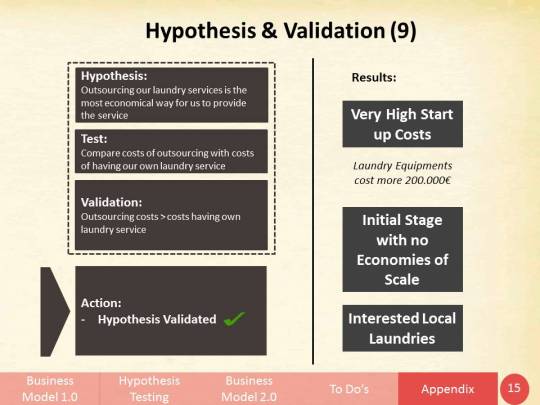
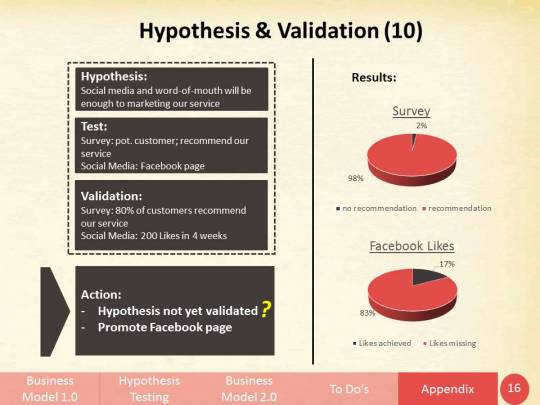
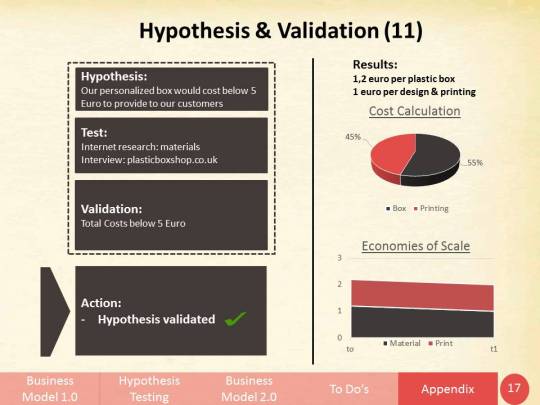
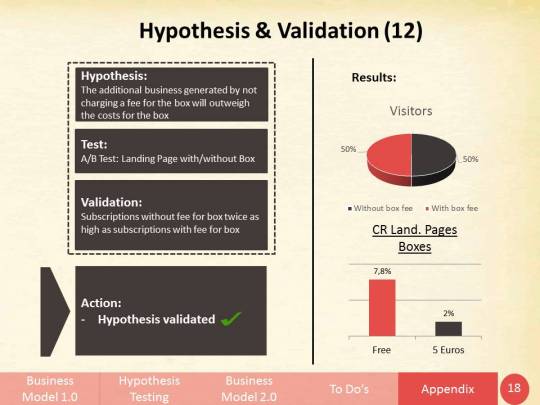

PART 2 - TESTING AND VALIDATION METHODS
Corporate Contacts (were used as part of the tests of hypothesis 5 and 7) – we have also had to contact some companies to access their interest in being our business partners. As part of the hypothesis testing we have contacted the Portuguese Post Office company, which is undergoing a major internal restructuring as part of their privatization initiative by undergoing an IPO, through its Academic Support Department contact, Mário Nobre. Although they valued our Entrepreneurial spirit and the idea, they said it would not be aligned with their core business activity but they thought we could achieve going step by step with our own distribution system. As part of the hypothesis testing we also contacted Natália Santos, from Oriflame (a cosmetic company) to access their interest in promoting their products by giving away free testers to our customers (which would be handed upon the delivery of the cleaned clothes) and paying us an advertisement fee. Although we are still talking to them (it’s a busy period for them), they believe their atomized individual vendors Business Model is not compatible means they don’t need this type of targeted advertising, but still they are accessing the overall potentialities of such idea, but we should start contact other companies like L’Óreal.
Wizard of Oz (was used as part of the tests of hypothesis 6) – finally, after we received our first orders upon launching the online order form on the 16th of November, we actually decided to simulate the service by our own with Ana (the first client, and also our very kind photo-shoot model, that we have already introduced to you here). Not only we have managed to talk to some local laundries, like the one we chose to drop out the clothes because it was the closest one (Lavandaria Europass), we have managed to discuss how the distribution process would be done and to estimate some costs. In Ana’s case, we used one of our group member’s car, a Smart for two, which has a gas spending performance of 6,5 litres / 100 km. From Ana’s place to a unique Lisbon central laundry, which would be interested and have the capacity to access all of our orders (like 5 à Sec’s Colombo laundry), would take us an average of 18km (pick-up and delivery) and with an average gas price of 1,54€ it would take us more than 27€ to do the distribution. As if we used the local laundry we would take less than 2km. By using 0 to 5 km local laundries radius we could drop the prices by at least 50% (compared to only using few centralized laundries with a minimum of 10km radius).
Cost Comparisons (were used as part of the tests of hypothesis 9 and 11) – besides doing this cost comparison, using our Wizard of Oz example, we also used this other method to do some more testing, mainly to start accessing how would be the impact of creating our own laundry from scratch, and still have our own distribution process. In the beginning, our Business Model 1.0 gave us the chance to go to the extremes of the scale, i.e., to outsource both laundry and distribution or to do both by ourselves. After, the post’s decline and suggestion for us to do it ourselves, and even initially to use some of our own already owned resources, like our own cars, we started to see how would the impact to create a laundry from scratch. Although is not easy to find data about it, we have managed to access from other start-up laundry initiatives that traditionally costs to create our own laundry would be of at least 200.000 euros and even with banking options like leasing it would still imply high start-up costs, especially if we would have our own distribution system, and we couldn’t achieve great economies of scale, without an initial big installed capacity. In addition, we also used this approach in order to access the production costs of the box, we also searched for materials pricings and decided that hard plastic would be the better price in a quality-pricing ratio, so we have calculated, using inputs from plasticboxshop.co.uk, that the overall production costs would not top the maximum 5 Euros fee charge we could charge our clients for it.
0 notes
Photo
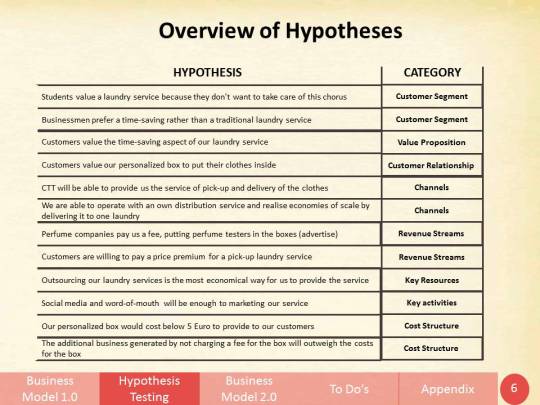

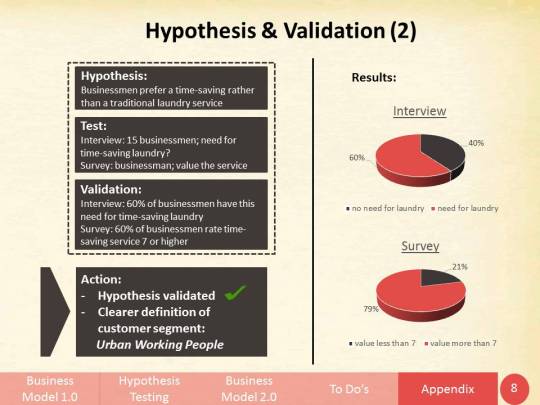

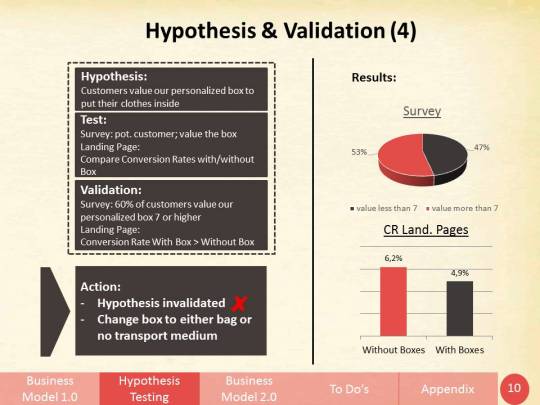

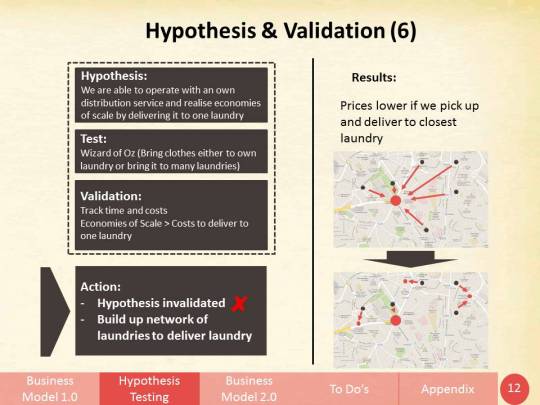
PART 1 - TESTING AND VALIDATION METHOD
Throughout the course we were taught several methods that we could later on use to test some of our hypothesis and have more valuable validations.
Interviews (were used as part of the tests of hypothesis 1, 2, 3 and 8) – One of the first most valuable methods we were taught were interviews, which are very valuable due to their face-to-face questioning characteristics. Although we still followed a script doing both the interviews to Students and Businessman (you can find the Script and Form used for Students and the Script and Form used for the Businessman in the links provided), the fact we were talking directly to one person allowed us to see their reactions to some of our questions and to develop some points which were spontaneously raised by the interviewee and were interesting for us. For example, it was due to interviews that we managed to cut off the idea of the public hotspots to drop out clothes and also that we should concentrate more on having an efficient distribution system that worked with a network of local laundries. We were surprised that most interviewees raised more privacy concerns rather than the expected security concerns, because they didn’t wanted to people see them dropping out dirty clothes. In total, we managed to do 35 interviews to Students (10 to non-local Portuguese students and 25 to international students) and 15 to Portuguese Businessman. The interviews were also useful to gain some first-hand insight of their perception on existing laundry services (which they believe they have good quality standards), but they still would value more a time saving service. It was also interest to see the ability to pay a premium fee for our service, even students, although they all placed the premium interest at the lower end, i.e., 0,5€ maximum premium.
Survey (were used as part of the tests of hypothesis 1,2,3,4, 8 and 10) – Although interviews are useful to gain first hand insights about what our customers think about some issues, they have a reach limitation since you can’t do interviews with hundreds of people without losing hundreds of hours. To gain insights of more objective questionings surveys are more efficient, and that’s why we have created a general survey for both our Customer Segments where we tried to feel their opinion about some particular issues using most entirely objective answers (you can find the Survey here). With this method we have managed to raise more than 178 replies, being 81% of the total responses from the Businessman (we really pushed to have more Businessman answers using close contacts to compensate the fewer Interviews done). The answers were particularly useful to check that our customers value a time saving service but have a lack of interest for our personalized box. It was also good to confirm the overwhelming interest in paying for an extra premium for using our service (only 10% of the people who answered the survey were not willing to pay an extra for it).
Landing Pages (were used as part of the tests of hypothesis 4, 8 and 12) – another real cool testing method we learned were landing pages, a web page that showcases our product and its features we want to promote, to access customer’s willingness to use it. They were not only pivotal to evolve the Minimum Viable Product 1.0 to the MVP 2.0 but also as part of the testing of some of our hypothesis, especially using the A/B testing method. A/B testing is used when you have two identical landing pages (pages A and B) that are only different in one aspect (a pricing, design, product features …). During the course we created 4 landing pages. The first two (a Portuguese and an English version to have into attention both Portuguese and International prospective clients) were part of the MVP 2.0 project and were created as part of our initial web strategy presence, and to access the overall interest of customers for our product (you can find the Portuguese version here and the English version here). The other two (which were intended to test if customers were willing to pay 5 Euros for the personalized box or if we gave it away for free the bigger impact it generated on business compensated the freemium aspect) were created on Unibounce and not on Kickoffpages like the first two, because our colleagues from Uniplaces created theirs in Unibounce and really liked their A/B testing feature (you can find the landing page in here, but be aware that we have assigned a 50% traffic chance for each so you are only available to see a version of the landing page, but if you access to the page in another computer automatically after you have accessed in the first one you can see the other version). In total we have managed to have 313 unique visitor in the 4 landing pages (211 in the initial two and 102 in the last two). Conversion rates were also different throughout the different landing pages: 6,2% in the first two landing pages (13 emails in three weeks; and a 9,3% conversion rate in the Portuguese page and a 4,4% conversion rate in the English page) and 5% in the last two landing pages with the boxes (7,8% in the landing page with the Free Box; and 2% in the 5Euros Box page). Overall, the interest for the landing pages with the boxes was not high and it was overwhelming that to have a handling mechanism to use to transport clothes it should be free, but the boxes don’t seem to have a good opinion with prospective customers (as already seen in the Interviews and Surveys).
0 notes
Text
Lessons Learned 1.10
Hey, everyone! Let's recap what we learned last week.
The great part of our class with João all groups presented their progress for 2 weeks including Business Model 2.0. It was really interesting to observe the changes from the first one, as frankly speaking, I personally thought, that our idea is solid and it will be difficult to change almost anything in the original plan.
Then we moved to Cost Structure in our business model as it is one of the most essential parts of the business plan. We described types of costs: fixed and variable, and gave a couple of examples for each. After that we learned about the balance between two of them as we cannot avoid any.
The next topic in our class was financial plan. Financial plan is a tool that helps manager or entrepreneur evaluate financial state of the company (current and future), evaluate future cash flows and all other finance-connected things using variables that are available to us now.
The main parts of the financial plan are Balance Sheet, Income Statement and Cash Flow Statement. Then we recapped on the templates for all three sheets and main concepts.
Then we talked about sources of financing: friends, family, ourselves, business angels, VC and some more. The most important source for us now are business angels - and João told us a little about right approach, evaluation of the firm, and the pitch.
The pitch is very important and should be thought-out elaborate and sophisticated. At the same time short, informative and memorable.
So our next big step (apart from big surprise) is to think over our pitch.
See you next class!
Sofia
0 notes
Photo





After almost the testings done we made some critical changes to our BM. We devided our changes into three categories:
1) Changed Hypothesis
Customer Segment – With the interviews and all of the work done during the course we refined our customer segments so we could communicate better to them. Regarding the students, we clearly think that we want to appeal to non-local students both Portuguese and international. Regarding the businessman, we still want to communicate to them but we think their customer segment should be Urban Working People since it’s less connotated to that men in suits stereotype, and we want to appeal to those first-time workers and the woman in the house that decides on the laundry options.
Key Partners – In a scale of options regarding our activities scope we could go to the extremes: or we outsourced both laundry and distribution and become the middle men whom could more easier be cut off from the scene; or we could do both laundry and distribution ourselves which in a very start-up stage would be very costly especially because we couldn’t achieve high economies of scale and could probably lose focus on either things. So we decided to outsource the laundry services but not to a unique laundry, but to a network of partner laundries that, are usually set in neighboorhoods and would be responsible for a particular area.
Cost Structure – Taking into account this last change we think that an important aspect of our service would be the monitoring of the quality of the service provided by the laundries so that everything is given to the client in the best quality as expected. Also, we abandoned the box idea, which was completely shut off in the testings. But the testings also showed that people still value the personalization of our service, and would value a free box if existed, and because we still needed a mean of transportation for the clothes we thought on recyclable laundry bags, which are consistent with the results of the testings done.
2) Rejected Hypothesis
Value Proposition – We were surprised but people actually valued our service and perceived it as a premium one, which they would be willing to pay for it, so that’s why we decided to remove the money saving aspect of our value proposition, because it no longer communicated our message.
Channels – We decided to focus on distribution, also because we didn’t found a partner that would be willing to use its existing distribution process in a flexible way, like the post company. Also the public hotspots were actually subject of a very negative consensual view on the interviews, people had a lot of privacy and security concerns and the ways to solve it (like hide them in not very public areas or have people survailling them) would completely g against its idea. So by focusing on an online flexible distribution service we could go at the encounter of our clients without needing this hotspots.
Revenue Streams – Because we drop our laundry services our main revenues would come from the margin on the transactions that would be based on a discount get from the laundries and the premium charged to the customers.
Key Resources – By outsourcing the laundry services and abandoning the hotspots idea we would focus more on our distribution facilities.
Key Activities – The same happens to our laundry as being one of ours main activities.
Key Partners – Also one of the implications of not doing the laundry ourselves would be the fact we would no longer need to partner to cleaning product suppliers and laundry machines manufacturers. Due to the post negative answer and ours initial willingness to focus on having our own distribution system we would no longer partner with them.
3) Added Hypothesis
Value Proposition – Since our customers perceived our service as a premium one and would be willing to pay that premium for using it we decided to add that premium service aspect as one of our value propositions.
Revenue Streams – by deciding on this Business Model our revenue stream would come mainly from the distribution fee we already talked earlier (margin from the discount get from laundries plus the premium customers would be willing to pay)
Key Resources – Now our main resources would be our distribution system comprised by the cars, the mobile GPS system, the internal calendar tool that determines the hours and dates of the different distributors and the distribution staff.
0 notes
Text
Combined Class Presentations of 21/11/2013 and 28/11/2013
Hi guys!
Here are the presentations of the two last classes! You can find here our Business Models 1.0 and 2.0, our Revenue Streams, Price Model, Key Activities, Key Resources and Key Partners. You can also find some pictures of our demo app and of our first client order and process!
Further on we are going to post more detailed posts about the changes in our BM and on the testings and hypothesis so please stay tuned!
0 notes
Text
Video Tutorial - Demo App
Here it’s or most expected Video Tutorial about our Demo App. We hope that now you can fully explore it:
https://www.fluidui.com/editor/live/preview/p_q11uUux4PxvpEMBUHTozUkVlUZ7eBc2y.1385643864360
0 notes
Text
Lessons Learned 1.9
Hi everyone!
Last class we had the pleasure to have Karina, the young entrepreneur that has already came to share with us some of her experiences, as our teacher.
After all of us doing our presentations, we learned about the importance of having a balanced team because most start-ups start with Technicians and continue only having them, which could be unsuccessful. Technicians are important to detect the problems and find the solutions, but you then need managerial skills of a Manager to sync all resources together and make people work. Finally, is important to have an Entrepreneur's vision to reinvent the business.
We then learned about the importance of processes, that allow us to have a clear and organized view of how the company works, so everyone and everything could work like a coordinated orchestra. Without processes everything could become a mess! But also having very large and complex processes could be inefficient because then employees don't know them and the effect could also be disastrous (processes shouldn't be that detailed at the point no one understands them). So with easy-following processes managers have a road map to solve problems and the company almost start to become automatized and synchronized, and life becomes less stressful. We made our own process that we will present next class, stay tuned to see it!
We also learned the importance of checking everything. Karina showed us a powerful video showcasing the importance a checklist in a medical operation room had in reducing the number of post-operations infections and deaths! It's true we learn with mistakes but some mistakes could have very harmful consequences!
We then learned about some useful organizational frameworks like the Porter's Value Chain, and it's lean start-up variation, which should be the basis of the subsequent processes definition.
About our Key Resources, the first thing that came in mind for all of us was the human resources and the people that make the business work! We've discussed some important situations like how a job position should be described, especially that all main aspects need to be clearly defined ex-ante so expectations are not defrauded and are correctly managed. We also learned how to design our own organizational chart and we've learned by Karina's friend example that attitude is sometimes more important than capabilities (because someone with the best capabilities but the worst attitude will be very hard to work with in the end).
We've also learned the term Chur Rate (it was in the job description form); number of clients that we had but left us! As a start-up is really important to learn form these clients!
Finally we talked about Key Partners and the different type of partnerships we can have:
Strategic Alliances = important collaboration between two different companies form different sectors
Cooperation = competing companies that create synergies together
Joint Ventures = start new business in a more leveraged and less risky way for each part
Buyer-Supplier = create strategic supply chains
And that when discussing partnerships is really important to put on the table the different proposal we offer each other!
Hope you also learned with us!
0 notes
Photo





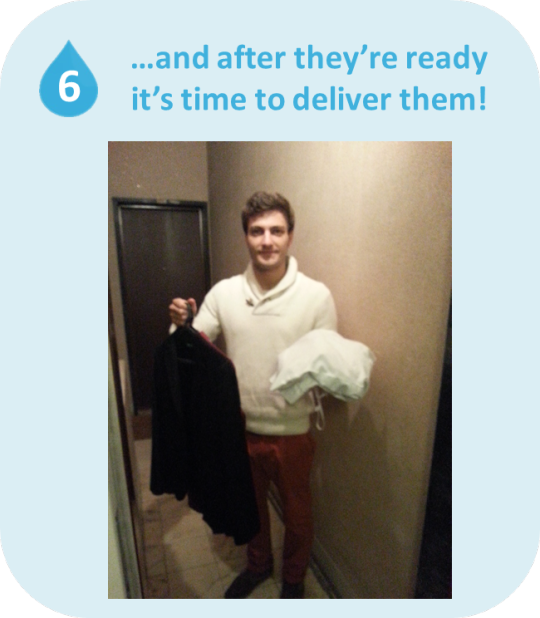
But we also did the process from our point of view:
After the client makes an order we receive an email with it;
At the set date and time we go to our client’s address using a live GPS system so we can use the shortest way and have on-time access to traffic;
Arriving at our client’s house he handles us its laundry bag and pays the service;
Then go to the nearest partner laundry to handle them the laundry clothes;
After the time set we go back to the laundry and collect the cleaned clothes;
We go back to the client’s house at the determined date and time and handle its cleaned clothes back;
0 notes
Photo



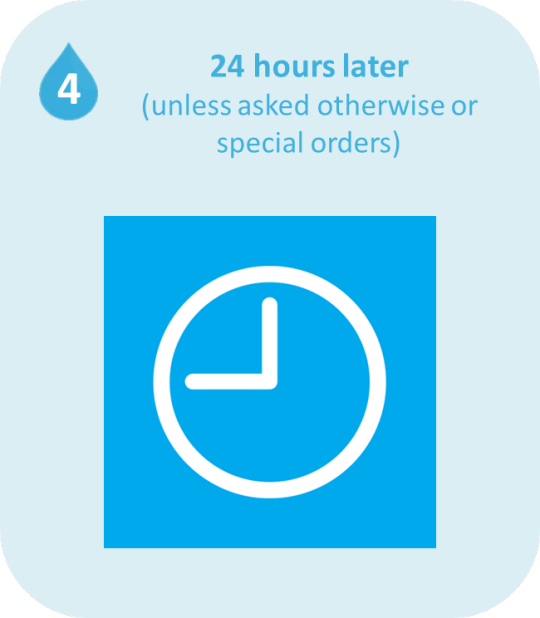


Processes
After doing the Wizard of Oz, which was one of our final testings, and our very first client accepted also to be our model for this photo shoot here you can find our process in the customer’s point of view:
First the client makes an order online and determines which services he wants, the pick-up and delivery dates and writes in any special notes he finds relevant for us;
The client puts its dirty clotjew on the laundry bag
On the set date and time we go to the determined address and the client hands us the laundry bag;
After the time determined, at least 24 hours, the client receives its clothes right back at home or in other wanted address;
And then you can enjoy your cleaned clothes!
0 notes



